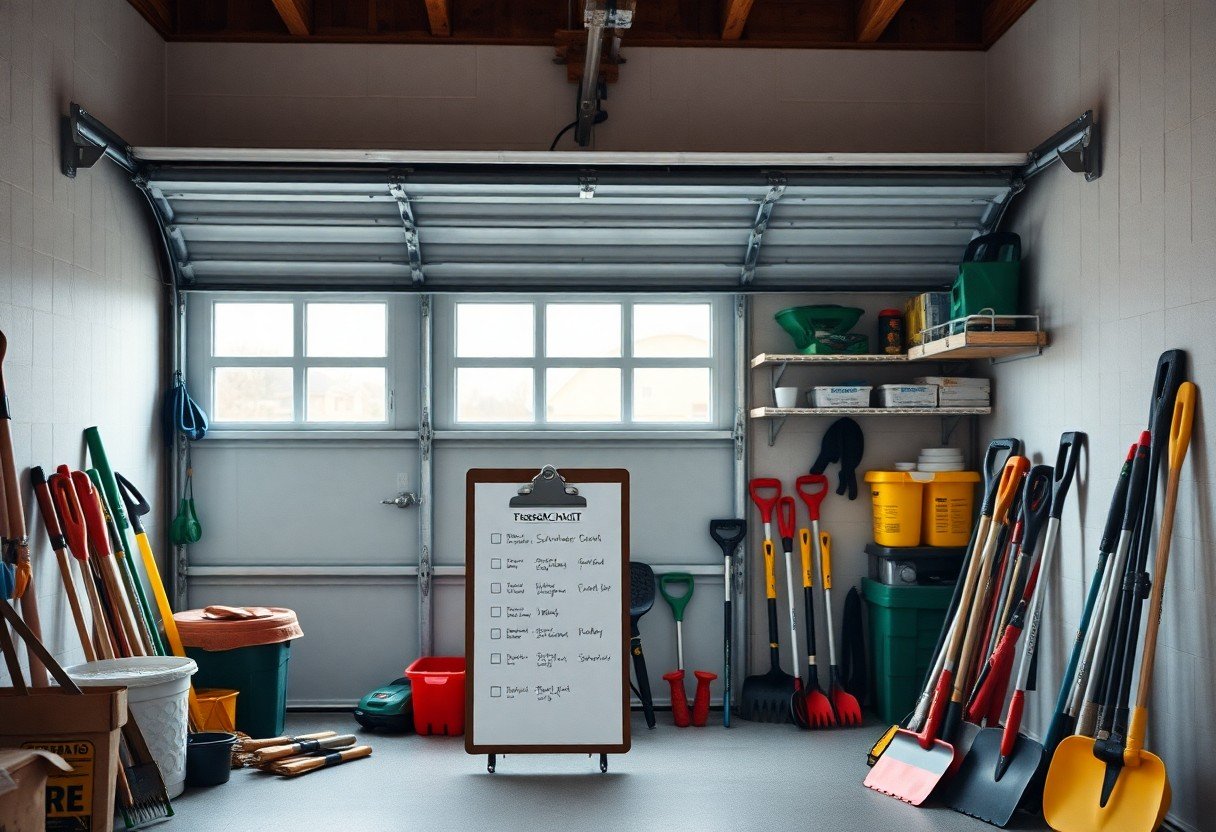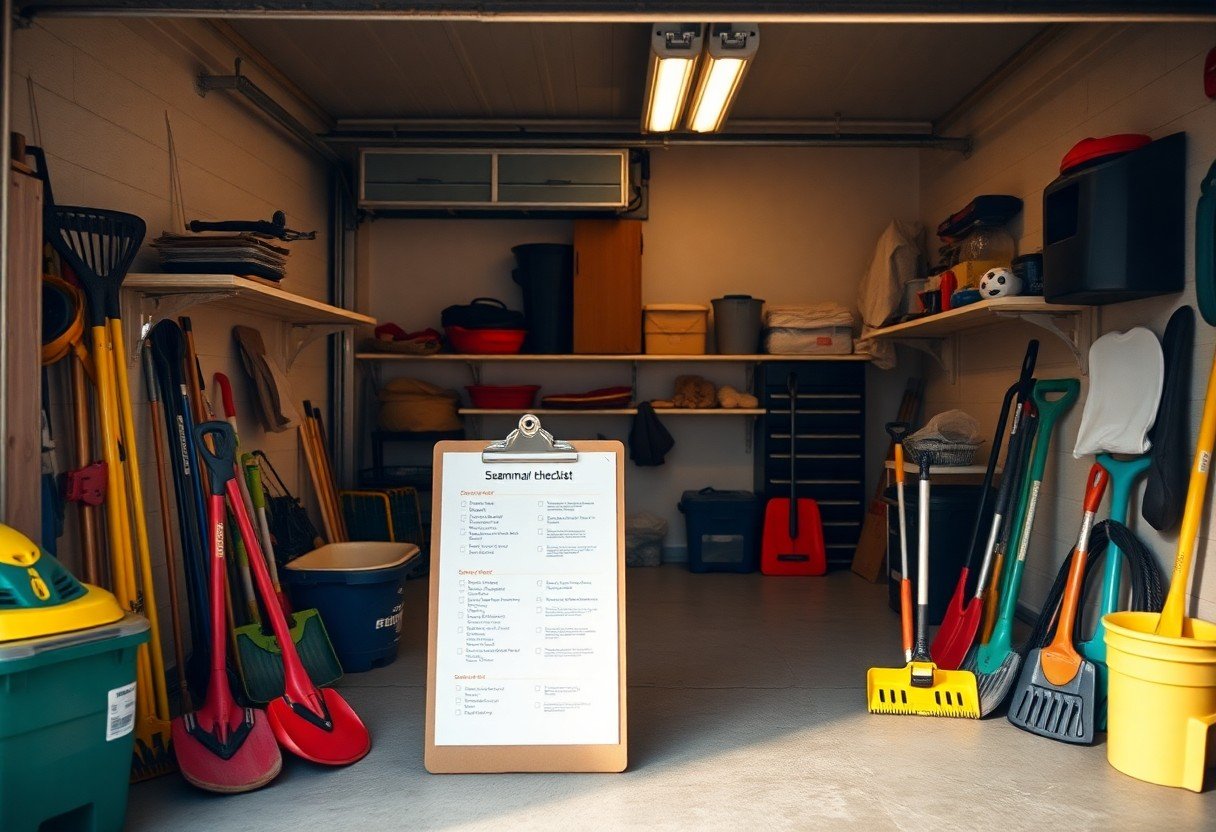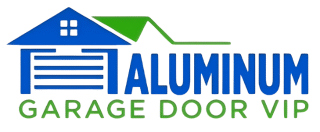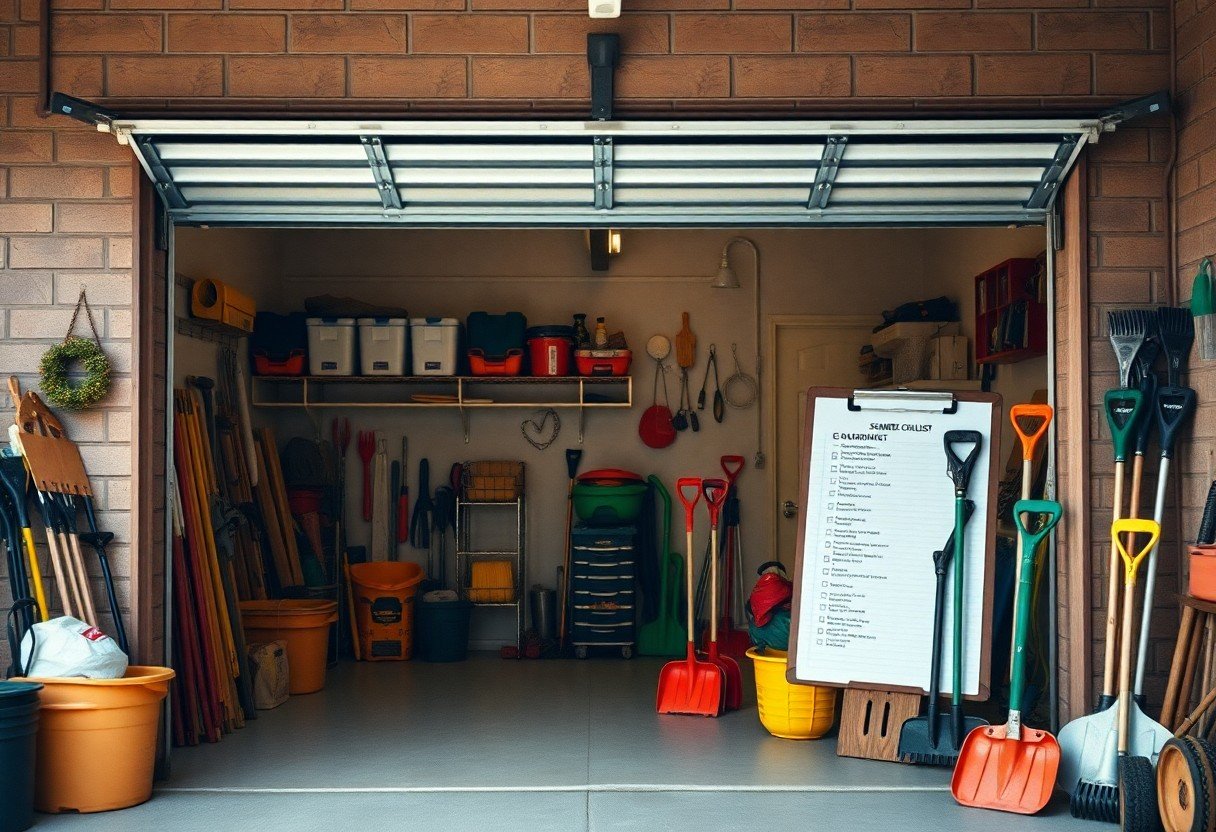
Garage Door Maintenance Checklist for Each Season
Over time, your garage door can experience wear and tear due to changing weather conditions and regular use. To ensure its longevity and optimal performance, it’s necessary for you to conduct seasonal maintenance. This blog post will guide you through a comprehensive checklist designed to help you keep your garage door operating smoothly all year round. By following these simple yet effective tips for each season, you can avoid costly repairs and enhance the security of your home.
Key Takeaways:
- Regularly inspect and lubricate moving parts such as rollers, springs, and tracks for optimal performance and longevity.
- Check the garage door’s safety features, like the photo-eye sensors and auto-reverse function, ensuring they operate correctly to prevent accidents.
- Clean and seal weather stripping and inspect for any damage to prevent drafts and maintain energy efficiency throughout the year.
The Winter Condition Challenge: Preparing for Cold Weather
Inspecting and Lubricating Moving Parts
Cold weather can negatively impact the functionality of your garage door. Before the chill sets in, inspect your garage door’s moving parts, including rollers, hinges, and tracks. Apply a silicone-based lubricant to prevent ice formation and ensure smooth operation. This simple step helps to avoid unnecessary strain on the motor and minimizes the risk of mechanical failure when you need your garage door most.
Monitoring Insulation and Sealing Gaps
Check the insulation and make sure that your garage door seals are intact before winter fully arrives. Gaps can allow cold air in, which not only makes your garage uncomfortably chilly but can also lead to higher energy costs as your heating system works harder to maintain warmth. Consider using weather stripping to create a tighter seal and prevent drafts.
Effective insulation plays a vital role in managing your garage’s temperature, preserving your belongings, and maintaining energy efficiency. Inspect the interior and exterior seals around the door for any signs of wear or damage. Replace any worn-out weather stripping to reduce drafts, as even tiny gaps can lead to significant energy loss. Keeping your garage well-insulated will not only increase your comfort but also contribute to the longevity of your garage door’s components during harsh winter months.

Spring Cleaning: Revitalizing Your Garage Door
Deep Cleaning Techniques for Every Surface
Start by giving your garage door a thorough wash using a gentle soap solution. For steel doors, a sponge and a mild detergent work wonders, while wood doors may require a specific cleaner formulated for that material. Don’t forget to scrub the tracks and rollers, where dirt and debris tend to accumulate. A garden hose with a spray nozzle can effectively rinse away soap residue, leaving your door looking fresh and new. To finish, consider applying a non-abrasive automotive wax to protect the surface from the elements.
Checking Weatherstripping and Seals for Replacements
Every spring, inspect your garage door’s weatherstripping and seals for wear and tear. Look for cracks, gaps, or brittleness that can arise from exposure to changing temperatures and harsh weather conditions. These components are crucial for keeping your garage insulated and protected from moisture, pests, and drafts. Replacing outdated weatherstripping not only improves energy efficiency but enhances your door’s lifespan, ensuring smooth operation even during the most demanding seasons.
A good strategy is to run your hand along the edges of the door to feel for any gaps or drafts. If you notice any issues, check the weatherstripping for signs of deterioration; it should fit snugly against the surface and create a tight seal. If you determine that replacement is necessary, choose high-quality materials designed for your door type. Enhanced seals can drastically reduce energy costs and prevent further damage caused by moisture infiltration, ultimately prolonging your garage door’s life.
The Summer Heat: Addressing Extreme Temperatures
| Maintenance Task | Recommended Action |
|---|---|
| Inspect Weatherstripping | Check for cracks or gaps; replace if needed. |
| Lubricate Moving Parts | Use silicone spray on rollers, hinges, and tracks. |
| Check Garage Door Opener | Test the reverse mechanism and security features. |
| Examine the Reviews | Look for signs of warping or bending due to heat. |
Understanding the Impact of Heat on Garage Door Function
The summer heat can cause materials like wood and metal to expand, potentially affecting the overall function of your garage door. High temperatures can result in warping or misalignment, making it difficult for your door to operate smoothly. In severe cases, this can lead to increased wear on components and even malfunctioning of the opener, necessitating more frequent repairs or maintenance attention.
Battery and Remote Control Maintenance Tips
Prolong the life of your garage door remote control by keeping it out of direct sunlight and extreme heat. Hot temperatures can drain batteries faster, so check them regularly and replace them as needed. You might also want to test the remote’s functions to ensure it operates correctly under various temperatures, as malfunctioning equipment can be a hassle during hotter days.
- Keep the remote in a cooler, shaded spot when not in use.
- Check battery levels every month, especially during summer.
- Consider using lithium batteries, as they perform better in extreme temps.
- Thou shall replace remote batteries if experiencing sluggish response.
The remote control doesn’t just operate your garage door; it also keeps you safe and secure. In the summer heat, test its range to ensure it functions properly from a reasonable distance. Consider having a backup remote on hand for emergencies, allowing for quick access if the primary one runs out of power unexpectedly.
- Store remotes indoors when not needed for protection.
- Ensure the remote’s buttons are not sticking due to heat expansion.
- Clean the remote comfortably to remove any dust buildup.
- Thou shall inspect the housing for any signs of damage.
The Fall Shift: Prepping for Seasonal Changes
Checking for Rust and Corrosion
As temperatures begin to drop, inspect your garage door for signs of rust and corrosion. Look closely at metal components, including tracks, hinges, and springs, as moisture accumulation can lead to deterioration. If you notice any rust, treat it promptly with a wire brush to remove loose particles, followed by a rust-inhibiting primer and paint to protect against further damage. Ensuring these areas are maintained can prolong the lifespan of your garage door and maintain its aesthetic appeal.
Tackling DIY Repairs Before Winter Hits
Now is the time for any DIY repairs that will fortify your garage door against winter’s chill. Simple tasks, like tightening loose bolts or lubricating moving parts, can keep your door functioning smoothly as temperatures plummet. Inspect the door’s balancing and alignment; misalignment can exacerbate issues in the winter when temperatures can cause metal to contract. A well-manufactured, healthy door is critical for winter efficiency.
Seizing this opportunity to tackle minor repairs will save you time and money in the long run. For instance, adjusting the tension on the garage door springs can prevent potential malfunctions during the freezing months. Consider checking the door’s automatic opener as well; increasing power efficiency and effectiveness can significantly ease your winter routines. Investing time in these details will create a seamless transition into the colder season, positioning your garage for optimal performance and security when winter arrives.

The Technological Edge: Smart Garage Door Maintenance
Integrating Smart Technology for Monitoring
Installing smart sensors on your garage door can significantly enhance your maintenance routine. These devices monitor the door’s operation, sending real-time updates to your smartphone or smartwatch. You gain insights into usage patterns and potential problems, allowing you to catch issues before they escalate, making it easier to maintain optimal performance.
Remote Diagnostics for Early Issue Detection
The implementation of remote diagnostics in your garage door system enables you to identify problems proactively. By creating a direct line of communication between your garage door and a mobile application, you can receive alerts about unusual sounds, unexpected movements, or any malfunctioning components.
This technology can analyze data derived from various sensors in real-time, giving detailed reports on door performance and wear levels. For instance, some systems utilize machine learning to track typical operational parameters, comparing them against recorded data. If the operating speed suddenly changes or the door struggles to open, you receive immediate notifications, allowing for timely intervention and preventing costly repairs down the line. Investing in such smart technology not only saves you from potential headaches but enhances the convenience and security of your home.
Safety First: Essential Precautions and Inspections
Conducting Regular Safety Tests on Sensors and Auto-Reverse
Test your garage door’s safety sensors and auto-reverse function monthly. Place an object, like a cardboard box, in the door’s path and close it. The door should automatically reverse upon sensing the object, indicating that the sensors are functioning properly. If it doesn’t reverse, you may need to clean the sensors or consult a professional for repairs.
Ensuring Proper Balance and Functionality of the Door
A well-balanced garage door is key to its longevity and safety. To check the balance, disconnect the door from the opener and manually lift it halfway; it should stay in place without assistance. An improperly balanced door can strain the opener and cause mechanical failures, leading to costly repairs.
To maintain optimally functioning garage doors, regularly check that they move smoothly along the tracks. Ensure the tracks are free of debris and aligned correctly. Screws, hinges, and rollers should be lubricated for efficient operation. An unbalanced door not only poses a safety risk but can also lead to premature wear on all mechanical components. By monitoring these aspects, you can avoid more significant issues down the line and ensure your garage door operates smoothly year-round.

Professional Insight: When to Call in the Experts
Common Signs That Indicate Professional Help is Needed
When your garage door starts making unusual noises, experiences stuttering motion, or if the automatic opener malfunctions without resolution, it’s time to consider professional assistance. Visible wear on the springs, cables, or a noticeable misalignment can also signal underlying issues that require expert intervention. Ignoring these signs can lead to bigger problems and potentially costly repairs down the line.
Benefits of Regular Professional Maintenance Checks
Scheduling regular professional maintenance checks ensures your garage door operates smoothly and safely. Technicians can effectively spot and resolve issues that may not be immediately obvious to you, thus prolonging the lifespan of your door. This proactive approach saves you money in the long term by preventing small concerns from escalating into major repairs.
Regular professional maintenance not only enhances the functionality of your garage door but also boosts your home’s security. Trained experts can inspect components, tightening bolts, and replacing worn-out parts, guaranteeing that your door is in optimal working order. With regular checks, you can expect increased efficiency, lower energy bills, and peace of mind, knowing your garage door is safe and reliable for daily use.
Budgeting for Maintenance: Cost-Effective Strategies
Estimating Your Annual Maintenance Costs
To accurately estimate your annual maintenance costs for your garage door, consider factors like frequency of inspections, part replacements, and whether you will take on any DIY tasks. For instance, routine checks might cost around $100 annually if done by a professional, while minor repairs can run between $50 to $200, depending on the issue. By budgeting approximately $300 to $500 for overall maintenance, you ensure that you cover most standard expenses, allowing for unpredictable repairs that may arise from wear and tear.
DIY vs Professional Services: Making Financial Decisions
Finding the right balance between DIY maintenance and hiring professionals can significantly impact your garage door budget. Simple tasks like lubricating moving parts or checking the balance can be performed by you at little to no cost. However, more complex repairs, such as spring replacement or electrical work, are best left to experienced technicians. Investing in professional service may seem expensive upfront, but it can save you from costlier repairs down the line.
Many homeowners often find themselves torn between doing it themselves and bringing in a professional. For smaller jobs, such as cleaning tracks or testing safety features, a DIY approach offers valuable savings and a sense of accomplishment. Conversely, complicated tasks—like replacing garage door springs—carry potential risks if tackled improperly. Ignoring these complexities can lead to greater repair costs later on. Assess the difficulty of the task and your comfort level before making a final decision, as it can help align your budget accordingly and ensure your garage door remains in optimal condition. For more insights, check out How to Maintain a Garage Door: Seasonal Maintenance Tips.
Final Words
Taking this into account, following a seasonal garage door maintenance checklist will help you ensure your garage door operates efficiently year-round. By performing regular inspections and maintenance tasks tailored to each season, you can extend the life of your door and prevent costly repairs. Stay proactive by reviewing Your Seasonal Garage Door Maintenance Guide for the best practices to keep your door in top shape.
FAQ
Q: What should I include in my winter garage door maintenance checklist?
A: During winter, it’s important to check for proper insulation and weather stripping to prevent drafts. Inspect the garage door’s springs and cables for any signs of wear, as colder temperatures can make materials more brittle. Additionally, lubricate all moving parts, including hinges, rollers, and tracks, to prevent freezing and ensure smooth operation. Keep an eye on the door’s balance by manually opening it halfway; if it doesn’t stay in place, it may need adjustments.
Q: How can I prepare my garage door for the spring season?
A: In spring, focus on a thorough cleaning of the garage door, removing dirt and grime that has accumulated over winter. Inspect the door for any damages or rust, and check the weather stripping for wear. It’s also a good time to test the garage door opener by ensuring it responds correctly to the remote and wall button. Lastly, apply lubricant to all moving parts to ensure optimal functionality as the weather warms up.
Q: What maintenance tasks are important for the fall season?
A: As fall approaches, it’s crucial to inspect the garage door for any cracks or damage that may have occurred over the summer. Check the alignment of the tracks to ensure smooth operation, and clean out debris that may have built up in and around the garage door area. This is also a great time to assess the weather stripping for any signs of wear, as it will prepare the door for the upcoming winter months. Consider testing the safety features, ensuring that the auto-reverse mechanism functions correctly.



